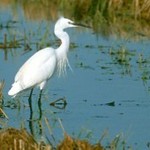 The changing nature of British bird life over the past 20 years is to be mapped in detail in a massive new survey by an army of more than 50,000 bird watchers.
The changing nature of British bird life over the past 20 years is to be mapped in detail in a massive new survey by an army of more than 50,000 bird watchers. New species, disappearing species, declines and recoveries will be plotted across Britain and Ireland over four years at a cost of more than L1m. Produced by the British Trust for Ornithology, it will be the third atlas of Britain's 230-odd summer breeding birds, and will be combined with the second atlas of the 20 or so additional species that regularly come to Britain for the winter.
Comparisons with the earlier atlases will give a detailed picture of the transformations brought about by forces such as the intensification of farming, and perhaps climate change.
The change between the BTO's first breeding bird atlas (for which the fieldwork was done in 1968-72) and the second (1988-91) exposed the massive declines in farmland bird species caused by the intensification of agriculture.
The new atlas, to be researched from 2007-11 and published in 2013, may show how effective the efforts of agri-environment schemes have been in bringing these species back.
It may also show the effects of climate change, and is likely to illustrate the mysterious recent decline in Britain's woodland birds, such as wood warblers and spotted flycatchers. Many are long-distance migrants and their decline may be linked to increasing difficulties on their journeys to and from Africa.
At its simplest, the atlas will show gains and losses. The most notable gain will be the little egret, the beautiful snow-white heron which began nesting in Britain in 1996 and has now spread across southern England. The principal loss will be the red-backed shrike, which went extinct in England after 1991.
For the first time, the atlas may pick up non-native birds, such as ornamental waterfowl or aviary escapes, which have started to breed in Britain.
The mapping will be based on 10km grid squares, and 3,879 squares will be surveyed. The BTO's Dawn Balmer, who will lead the project, said: "We should be able to see whether we are getting to grips with problems that came to light in the last atlas and focus conservation efforts on new priority areas."



